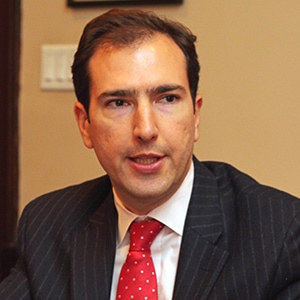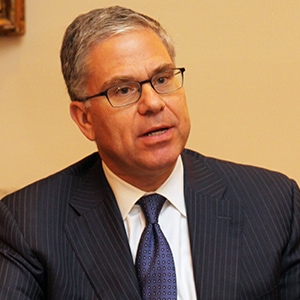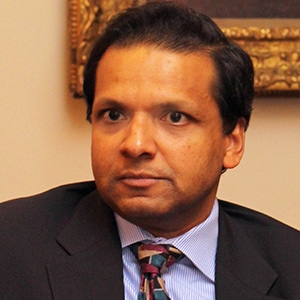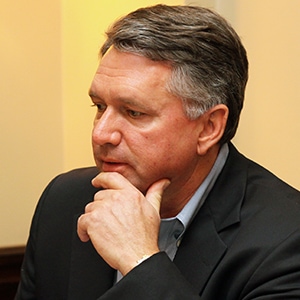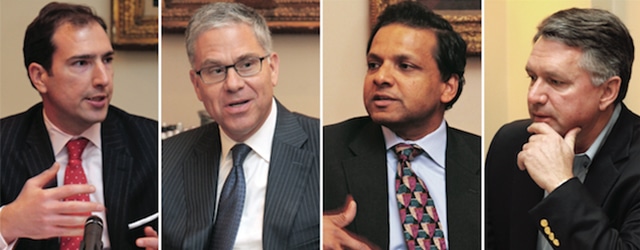
MEET THE PANELISTS
BUILDING A TREASURY CENTER OF EXCELLENCE
Treasurers from leading F500 companies and executives from top banks gathered at the Harvard Club in New York to discuss how treasurers are leveraging new market developments to improve treasury operations.
Moderated By Joseph Giarraputo
Global Finance: A key role of the treasurer has always been managing risk. How has your focus on counterparty risk developed in the face of regulatory and market changes?
John Tus, vice president and treasurer, Honeywell International: For us the primary focus is on our investment area, where we have very conservative policies. For particular banks we’ll look at a number of different metrics, including credit default swaps, stress test results and credit ratings. We also consider the risks in countries where deposits may not be protected by government guarantees in the event of a bank default.
Ashok Madhavan, vice president and treasurer, Campbell Soup: The primary tool we use is the credit rating. We all know that’s a very dated measure, as we saw in 2009—but it’s the best we have. I don’t have a huge staff to do a deep analysis of every bank’s balance sheet, so we rely on published credit ratings and keep abreast of any changes. Ultimately, our best tool is ensuring that our mark-to-market position with a counterparty is always controlled within acceptable limits.
Stefan James, managing director, head of corporate banking coverage, North America, Deutsche Bank: Banks are in the counterparty risk assessment business, so that’s our strong suit. We want to help treasury teams think about alternative means of deploying liquidity that allows them to remain within their risk protocols.
Our job is to communicate clearly how we operate in various jurisdictions around the world and explain to treasurers what they can expect of their key financial counterparties so they can build out their capabilities appropriately.
Banks can provide access to data for corporates, giving visibility into cash across their footprints and contributing to analytical work across multiple financial partners and operations.
Michael Berkowitz, managing director, Treasury and Trade Solutions, Citi: Twenty years ago, companies primarily looked at the major credit ratings when evaluating fixed-income counterparties. Now they utilize a whole range of different measurements, which can include credit default swap spreads and profitability. They are also looking at things like capital ratios, which are now available under the new regulations.
GF: Moving on to geopolitical risks, how are corporate treasurers planning around this type of risk, and how are banks working on this topic with corporate clients?
Tus: We think about the implications for us with respect to our business in a particular country. We also look at our exposure from the standpoint of our net investment in the country. We ask what cash we have in the country and how able we are to dividend or lend that cash out of the country at short notice. In addition we look at currency implications: Is cash being held in the local currency or in US dollars?
I would add that in business you are focused on driving growth that may be challenging, given the country you are in. Many countries that have gone through war, significant economic and political instability including regime change, ultimately are in a state of rebuilding. So there may be opportunities for infrastructure companies to build roads, bridges, airports, buildings or power plants.
Madhavan: For us, geopolitical risks are more about trapped cash than political stability. We are more focused on entities that have nonconvertible currencies or trapped cash that we are not able to access. Then it becomes a question of moving that cash out of the country and converting it to a hard currency.
James: Banks have seen an increasing focus by treasury teams on how they are capitalizing and funding their subsidiaries in problematic areas of the world. Increasingly they are looking at how to fund operating entities locally, with trapped liquidity and the convertibility of currency being the driving force.
Berkowitz: As a global bank, we have an on-the-ground presence in a number of developed and developing markets, including, for example, Russia, Ukraine and many of the Middle Eastern countries. We have established risk councils in the problem areas and are spending a lot of time advising clients how to minimize idle cash balances.
Treasuries are also increasingly using multibank target balancing structures to move cash out of various countries and into regional treasury centers, using visibility tools to know exactly what they have in each of those countries.
GF: What other major risk areas are you concerned about from the treasury perspective?
Tus: When you think about treasury, you think about investing and ensuring that your cash is safe. You look at foreign exchange and commodities risk and how the business is being funded. I think that foreign exchange is an area where there’s a little more focus today—particularly given the fact that there seems to be divergence in central bank policy, particularly in the US and Europe.
Madhavan: One of the areas of growing concern is cyberrisk. It sounds like it shouldn’t be a problem at companies with strong controls, but you always have to be alert, as some of these cyberthreats can be very sophisticated.
I think this is one area in which the insurance carriers need to catch up. You look at all kinds of insurance policies to protect yourself against financial damage caused by cyberthreats. But by the time you go through all the fine print of all the renunciations of coverage in most current policies, you are basically left on your own.
Berkowitz: To Ashok’s point, we take cybersecurity risks extremely seriously and invest in our own infrastructure and employ the most-sophisticated technology to guard against these and other operational risks.
In addition, we also provide increasingly sophisticated online tools to our corporate clients that guard against potential risks. These include tools like payee name authentication on the payee side, as well as fraud alerts on the commercial credit card side or even on the traditional payment side. The importance of timeliness of information cannot be overemphasized. We enable our treasury clients to increase real-time delivery of information via various channels including tablets and smartphones.
GF: Despite improved analytics and greater transparency into cash flows, companies still struggle to produce accurate and timely cash forecasts. Why is it still a challenge? What are companies doing to improve their cash forecast?
Tus: Forecasting challenges are often related to the processes used. At the business unit level, the business unit looks at a quarter and does a sources and uses analysis of the business. This includes the cash expected to come in based on the sales and collections, as well as the major outflows.
At the corporate level, we really look at our collections on a daily basis, as well as looking at some of the major outflows for the quarter. This serves us very well as we can track that quarter against historical data and against our own analytical cash flow forecast for the quarter, based upon actual daily collections and expenditures.
Madhavan: A lot depends on the discipline within a company. We have purchased small companies that have had greater discipline around their cash flow processes than bigger companies. The ones that are good at cash forecasting are those that have had to focus on the daily cash ins and outs in order to be able to minimize the amount of their borrowings, due to constraints on the availability/cost of their credit lines.
You can put in all the technology in the world, but if you don’t think about your cash flows and don’t have any discipline around it, it’s not going to help. The tone has to be set at the top that working capital is important.
Berkowitz: Surveying our corporate clients, we find that 96% do some form of cash flow forecasting. But more than half of them are using spreadsheets or very low technology methods.
Technology is important, but process and organization are important as well. You could be using a spreadsheet but have a very centralized process for cash flow forecasting. And that may work for the company.
As the Federal Reserve starts to drain liquidity from the system and cash becomes increasingly scarce, it will be necessary to perform more-rigorous cash flow forecasting. Banks can provide the data, and technology to help corporate clients with that.
GF: In the face of continuing low interest rates, many companies are still holding on to cash rather than investing back into the business. Are companies starting to see yield or still protecting principal?
Tus: My experience is that companies continue to remain relatively conservative with regard to their cash. It’s very difficult to make a difference when you are trying to invest cash, especially if the cash is not necessarily available to be invested at a long tenor. The key thing is taking that cash and having it in a position where you’re able to deploy it toward higher returning investments.
Madhavan: I would say it is definitely the preservation of principal. Nothing ruins your day worse than having a call from someone who tells you your money is stuck. It’s just not worth the risk, especially to pursue a few extra basis points in the very low yield environment that we’re facing around the world.
When you invest in something, you should never rely on just what’s being marketed, but really understand what you are investing in.
James: I would say that in the four years following the financial crisis, preservation of capital was the most important objective for corporate treasurers. But the problem of rapidly growing cash balances on corporate balance sheets is well documented, with many corporates having publicly communicated ROIC [return on invested capital] targets. Four billion dollars on a balance sheet can be problematic, particularly if it’s deployed in a very low yield environment.
As a result, we’ve begun to see more openness to sound but enhanced yield proposition for cash. Corporate treasurers are reevaluating the functional currencies in which they operate at times where yield differentials are relevant. So while I do agree that any sort of loss of principal is really not acceptable, I think treasurers are being increasingly thoughtful about avenues to deploy cash in a more profitable manner.
Berkowitz: I would agree that preservation of principal still remains the most important objective with regard to their corporate cash. But I think corporate clients are more confident now in the methods they’re employing to evaluate counterparty risks. They are starting to think about other issues such as liquidity and how they can earn a little more within the framework.
GF: Global regulatory changes can impact liquidity considerations. What are the key concerns and challenges?
Berkowitz: Basel III has a direct impact on the way that banks measure themselves, including new and more-stringent capital ratios and liquidity ratios. As a result, banks are reevaluating how they deploy their balance sheet. Deposits linked to core underlying cash management activity become more favorable from a regulatory perspective, whereas non-operating cash becomes much more problematic for banks to hold in a constrained-balance-sheet environment.
In addition, with money market funds moving to a floating net asset value, there will be a significant impact on how corporate treasurers view them as a cash equivalent. Many of them are thinking about moving to alternative investment types which will continue to have a stable net asset value, such as government funds and bank deposits.
Tus: I would agree. From the corporate’s perspective we’re looking at it from a liability side and saying, what is the cost of liquidity? Is it going to increase? Then on the asset side, we’re looking at the changing landscape and asking whether we really want to go into prime money market funds if we don’t have the access to our cash.
GF: Have you seen a difference in corporate behavior in terms of the hedging strategies lately?
Madhavan: I don’t think our hedge strategy has changed dramatically. We have guidelines for all the business, and when there are exposures that exceed certain dollar thresholds, they need to come and talk to treasury, and we put together hedging plans on an annual and monthly basis.
James: I don’t think we’ve seen corporates behaving differently. If the industry is expecting a cyclical appreciation in the value of the dollar, corporates who are heavily invested in markets outside of the United States are going to have to meet that development head on. But generally speaking, the organizations we work with have had consistent views around hedging policies for some time.
Berkowitz: I would agree with that. What I would say though is that as companies globalize in our increasingly volatile markets, they may need to employ more-sophisticated hedging strategies. But that’s evolved relatively slowly so far.
GF: How have regulatory changes and the knock-on effect on global banks affected trade finance use and availability? What are corporates doing to adjust to these changes?
Tus: The issue for many of our suppliers is liquidity. So trade finance can be a benefit for them as a relatively inexpensive source of liquidity. Some banks have told us that the credit landscape will be challenged as a result of Basel III for many smaller companies, so they will be looking for alternative sources of liquidity.
Madhavan: We have been partnering more with banks. We are very interested in extending terms for suppliers, but we are quite sensitive to the fact that some are small companies for which this can cause difficulties. So we are fairly selective about where we extend terms.
Where we’re looking to get help from banks is in taking advantage of supplier financing opportunities which enable us to help suppliers, rather than imposing a burden on them.
Berkowitz: Basel III, with its focus on capital metrics that use risk-weighted assets as a denominator, will make the provision of credit to non-investment-grade companies more expensive. I think that’s already started to occur, albeit slowly.
The use of supplier finance programs certainly provides a means for non-investment-grade suppliers to take advantage of the better credits of their customers, when that is the dynamic in play. So we have seen increasing interest in supplier trade finance for those types of relationships.
James: We believe we’re on the cusp of a new wave of supply chain management. A lot of what we’ve seen over the last five to ten years has been about stretching out payment terms with key suppliers and yet being mindful of their financial health by providing financial support through partnerships with banks. We’ve seen some risk mitigation, particularly in regards to receivables, and also managing a corporate’s investment and working capital.
I think what we’re going to see moving forward is a much broader view of the application of some of these principles across geographies and across currencies. This will all be done under common programs with single groups of banks providing the funding solution on the supply chain finance side.
We are also seeing the distributors that organizations rely on can be very thinly capitalized. It is crucial that their finances remain healthy, and I think organizations are looking at ways to partner with banks to help strengthen the financial condition of their key distributors around the world.
Very often with supply chain finance programs the demands stretch beyond any single firm’s ability to provide the entire solution. So the ability to educate banks around the world about the product and to create channels to syndicate and distribute risk is another element of what we see going on in this industry.
GF: The role of treasurers is not just that of financial manager, but also a manager of a team. How focused are you on training and career development for your treasury team?
Tus: Whenever we’re working on a particular project, it is important to get the junior people involved so that they get to see the flow of ideas, the critical decisions that are made, and how we came about those decisions.
We also find out from individuals what they want to do with their careers. We leverage our banking relationships to get them specialized training—whether that’s in derivatives or foreign exchange or cash management—and encourage them to attend a lot of conferences. We really want them to build their career and get something out of it.
Madhavan: At Campbell Soup we have a program where we rotate people in and out of treasury. So people come in from the business unit, spend three or four years in a treasury position and then rotate out to one of our other divisions. We can train them to think critically about financial investments, which then seeds the rest of the organization with
good financial discipline.
But we also want to make treasury a career in the organization and retain people with experience. So we identify people in the rest of the organization with high potential that we think would do very well within our treasury, and we try to bring them in.
This last year we’ve been partnering with Drexel University’s LeBow College of Business, [which focuses on] corporate and executive education, to create an internal management course for Campbell Soup employees, revolving around treasury management. It’s one way for people to get a sense of whether it is a career path for them.
We also work closely with our banking partners to help in training our people. When we send people down to some of the banks for the first time, it can be quite an eye-opener for them to actually see a trading room in operation.
GF: As banks, you see lots of treasurers, and you talk about their operations and markets round the world. You see the good, the bad and the ugly. Do you pass on any organizational advice?
James: As bankers we see some extremely well run treasury organizations. To the extent that there are certain practices, disciplines and approaches to treasury that we believe are consistently successful, we do share best practices with clients.
I’ve noted that quarterly earnings presentations are increasingly including key metrics around working capital management and the treasury function generally. There’s so much more visibility into the role of the treasury organization and its impact on earnings and profitability of the organization. So it’s clear that the standards have been raised in a very
positive way.
Berkowitz: At Citi we have a treasury advisory and consulting practice. We also have a service called treasury diagnostic that benchmarks different corporate treasuries against their peers, along with a variety of different metrics including centralization, technology and organization. We try to share best practices and advice with our clients. We also employ former corporate treasurers in that advisory practice, so they can bring unique insights to our clients. n
